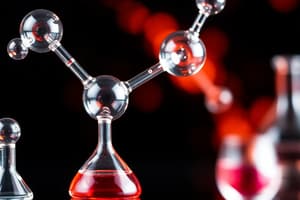Podcast
Questions and Answers
Which of the following are characteristics of inorganic compounds? (Select all that apply)
Which of the following are characteristics of inorganic compounds? (Select all that apply)
- Compounds made up of ionic or polar covalent bonds (correct)
- Compounds made up of mainly C and H
- Not soluble in water
- Soluble in water (correct)
Which of the following are characteristics of organic compounds? (Select all that apply)
Which of the following are characteristics of organic compounds? (Select all that apply)
- Not soluble in water (correct)
- Compounds with high melting and boiling points
- Soluble in water
- Compounds made up of mainly C and H (correct)
What composes an organic compound?
What composes an organic compound?
Mainly carbon and hydrogen
What commonly distinguishes inorganic compounds from organic compounds?
What commonly distinguishes inorganic compounds from organic compounds?
What kind of bonds do organic compounds mainly contain?
What kind of bonds do organic compounds mainly contain?
What defines a compound as inorganic?
What defines a compound as inorganic?
Organic compounds have high melting and boiling points.
Organic compounds have high melting and boiling points.
Inorganic compounds usually have strong distinct odors.
Inorganic compounds usually have strong distinct odors.
Match the following terms with their definitions:
Match the following terms with their definitions:
What is 2-Methylpropane?
What is 2-Methylpropane?
What is the functional group of alcohols?
What is the functional group of alcohols?
What distinguishes aldehydes from ketones?
What distinguishes aldehydes from ketones?
What is a key feature of carboxylic acids?
What is a key feature of carboxylic acids?
Amines and amides contain a nitrogen atom.
Amines and amides contain a nitrogen atom.
What is an ether?
What is an ether?
What is an aromatic compound?
What is an aromatic compound?
Flashcards
Inorganic Compounds
Inorganic Compounds
Compounds primarily composed of metals and nonmetals, forming ionic or polar covalent bonds.
Organic Compounds
Organic Compounds
Compounds mainly containing Carbon (C) and Hydrogen (H), often with other elements like Oxygen, forming covalent bonds.
Hydrocarbons
Hydrocarbons
Organic compounds consisting only of carbon and hydrogen.
Alkanes
Alkanes
Signup and view all the flashcards
Isomers (Alkanes)
Isomers (Alkanes)
Signup and view all the flashcards
Cycloalkanes
Cycloalkanes
Signup and view all the flashcards
Haloalkanes
Haloalkanes
Signup and view all the flashcards
Functional Groups
Functional Groups
Signup and view all the flashcards
Alkenes
Alkenes
Signup and view all the flashcards
Alkynes
Alkynes
Signup and view all the flashcards
Alcohols
Alcohols
Signup and view all the flashcards
Ethers
Ethers
Signup and view all the flashcards
Carbonyl Group
Carbonyl Group
Signup and view all the flashcards
Carboxylic Acids
Carboxylic Acids
Signup and view all the flashcards
Study Notes
Inorganic Compounds
- Soluble in water, acting as a polar solvent.
- Generally composed of a mix of metals and nonmetals.
- Comprise ionic or polar covalent bonds.
- Typically have high melting and boiling points.
- Usually lack distinct odors and are not flammable.
Organic Compounds
- Not soluble in water; soluble in nonpolar solvents.
- Composed mainly of carbon (C) and hydrogen (H), with possible inclusions of oxygen (O), sulfur (S), nitrogen (N), fluorine (F), chlorine (Cl), bromine (Br), or iodine (I).
- Mainly formed through covalent bonds.
- Characterized by low melting and boiling points.
- Often have strong distinct odors and are flammable.
Hydrocarbons
- Consist exclusively of carbon and hydrogen atoms.
- Include categories such as alkanes, alkenes, alkynes, and aromatic compounds.
Alkanes
- Examples: Methane, Ethane, Propane, Butane, Pentane, Hexane, Heptane, Octane, Nonane, Decane.
- Known as saturated hydrocarbons, containing only single bonds between carbon atoms.
Isomers of Alkanes
- Example: 2-Methylpropane has three carbons in the main chain, with a branch off the second carbon.
Cycloalkanes
- Formed in cyclic or ring structures, maintaining a skeletal shape.
Haloalkanes
- Halogen atoms (e.g., chlorine, bromine) replace one or more hydrogen atoms in alkanes or cycloalkanes.
Functional Groups
- Define organic families with specific structural features; vital for classifying organic compounds.
Alkenes and Alkynes
- Alkenes: Contains a double bond (H2C=CH2).
- Alkynes: Contains a triple bond (HC≡CH).
Alcohols and Ethers
- Both contain oxygen; alcohols have a hydroxyl group (-OH), while ethers consist of an oxygen connected to two carbon atoms.
Carbonyl Group
- Central in aldehydes and ketones, characterized by a carbon-oxygen double bond.
- Aldehydes bond the carbonyl carbon to at least one hydrogen atom.
- Ketones bond the carbonyl carbon to two other carbon atoms.
Carboxylic Acids and Esters
- Both include the carboxyl functional group, combining carbonyl and hydroxyl groups.
- Carboxylic acids have a hydroxyl group bonded to a hydrogen atom.
- Esters have the oxygen bonded to a carbon atom instead of a hydrogen.
Amines and Amides
- Contain nitrogen, with amines having carbon groups bonded to the nitrogen atom.
- Amides feature a nitrogen group replacing the hydroxyl group in carboxylic acids.
Studying That Suits You
Use AI to generate personalized quizzes and flashcards to suit your learning preferences.




